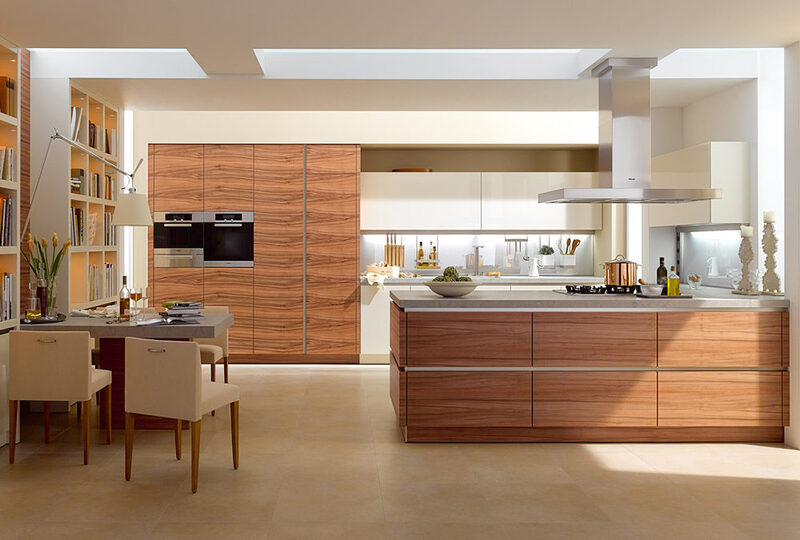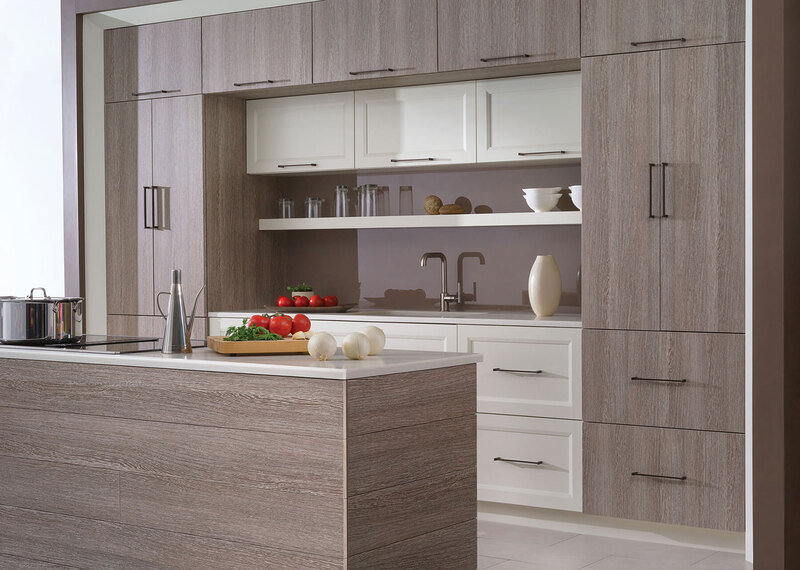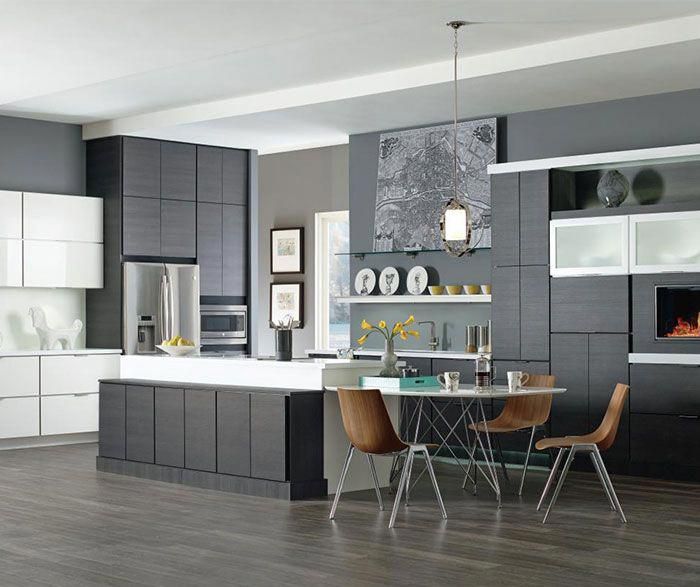Laminate cabinets are a popular choice in modern kitchens and bathrooms due to their durability, affordability, and versatility.
They are constructed by adhering a thin layer of printed or solid-colored laminate material to a substrate, typically made from particleboard or medium-density fiberboard (MDF). The laminate layer is a resin-saturated material that provides a hard, smooth surface, which can be finished in a variety of colors, patterns, and textures, emulating the appearance of wood, stone, or other materials.

This makes laminate cabinets an attractive option for those who want aesthetically appealing yet budget-friendly choices.
Additionally, they are resistant to stains, moisture, and scratches, making them practical for high-traffic areas like kitchens, bathrooms, and commercial spaces.
For contractors, furniture brands, and companies seeking cost-effective solutions, laminate cabinets offer the perfect balance between design flexibility and functional resilience.
Table of Content
1. Laminate Cabinet Pros
Laminate cabinets offer several advantages, making them a popular choice for various commercial and residential projects:
- Affordability: Laminate cabinets provide a cost-effective option without sacrificing style or functionality. They offer high-end looks at a fraction of the cost of materials like hardwood.
- Durability: Known for their resistance to scratches, stains, and heat, laminate cabinets are ideal for busy kitchens, bathrooms, and even office environments. This durability ensures that the cabinets maintain their appearance over time, even in high-traffic areas.
- Wide Range of Design Options: With a wide range of colors and patterns, laminates can emulate the appearance of wood, stone, or other materials, allowing for versatile design options. This flexibility is especially beneficial for contractors working on diverse projects, from retail stores to residential kitchens.

- Low Maintenance: Laminate cabinets are easy to clean, requiring just a simple wipe-down with a damp cloth and mild detergent. This makes them an attractive choice for companies managing commercial spaces or rental properties.
- Eco-Friendly: Many laminates are made from recycled materials, making them a greener option. For businesses focused on sustainability, laminate cabinets offer an environmentally responsible solution.
Related post: Low VOC Cabinets – Healthier Solutions for Contractors and Cabinet Brands
2. Laminate Cabinet Cons
Despite their many advantages, laminate cabinets have some drawbacks:
- Susceptibility to Chipping and Peeling: Over time, laminate can be prone to chipping and peeling, especially in high-use areas such as kitchens and bathrooms. This is a concern for contractors who need long-lasting materials in busy spaces.

- Difficult to Repair: Unlike solid wood cabinets, laminate cannot be sanded down and refinished. If the surface is damaged, it often requires complete replacement, which can increase maintenance costs for long-term projects.
- Less Heat-Resistant: Laminate is not as heat-resistant as other materials like solid wood or metal. Exposure to high temperatures can cause the laminate to bubble or warp, which makes it less ideal for environments where there’s significant heat exposure.
- Limited Natural Appeal: While laminates can mimic the appearance of natural materials, they lack the authentic texture and feel of real wood. For premium projects, this might be a limiting factor in creating a high-end look.
3. How Much Do Laminate Cabinets Cost?
The cost of laminate cabinets is one of their most attractive features, especially for large-scale projects. Here’s a breakdown of the typical costs:
- Standard Kitchen Renovation: Laminate cabinets for a standard kitchen renovation typically range between $3,000 and $5,000. Higher-end laminate options or custom designs can increase this cost.
Learn more: Cost of Custom Cabinetry - A Comprehensive Guide

- Per Linear Foot Pricing: On average, contractors can expect to pay between $50 and $200 per linear foot of laminate cabinetry, depending on the quality of the material and customizations.
- Custom Designs and Finishes: For custom designs, higher-quality finishes, or thicker laminate sheets, the price can rise to $300 per linear foot. These cabinets are often used in premium projects where durability and design are equally important.
Additional costs to consider include labor, hardware, and any specialty finishes. Contractors and brands should obtain multiple quotes to ensure competitive pricing, especially for larger commercial projects.
4. Installing Laminate Cabinets
Proper installation is key to ensuring that laminate cabinets perform well and last long. Contractors and cabinet installers must follow these steps for a successful installation:
- Accurate Measurements: Begin by taking precise measurements of the space to ensure the cabinets fit perfectly. Double-check all dimensions to prevent installation issues later on.
- Support and Alignment: Install a ledger board to support the cabinets during installation. This helps keep the cabinets level and balanced while securing them to the wall studs with screws.
- Start with Upper Cabinets: Begin by installing the upper cabinets to avoid having to work over the base units. Each cabinet should be leveled and aligned before moving on to the next to maintain consistency.
- Secure the Base Cabinets: Once the upper cabinets are installed, move on to the base cabinets. Attach them to the wall studs and to each other for stability, ensuring they are level throughout.
- Install Hardware and Final Adjustments: Finally, attach the cabinet doors and drawers, making any necessary adjustments to ensure proper alignment and smooth operation. Install handles, knobs, and any additional hardware as needed. Learn more: Cabinet Hardware Size Guide
5. Tips To Repair And Maintain Laminate Cabinets
Laminate cabinets are relatively low-maintenance, but they still require proper care to ensure longevity:
- Regular Cleaning: Clean laminate surfaces with a damp cloth and mild detergent to remove dirt, grease, and grime. Avoid using abrasive cleaners, as they can scratch the surface.
- Repairing Minor Damage: For small chips or scratches, use a laminate repair kit that includes filler sticks and touch-up markers. These tools can blend imperfections into the cabinet’s color and texture.
- Handling Peeling Laminate: In cases where the laminate starts to peel at the edges, a strong adhesive can be used to reattach the surface. Secure the laminate in place with clamps until the adhesive dries fully.
- Preventing Heat Damage: Avoid exposing laminate cabinets to excessive heat. Place heat-resistant barriers between laminate surfaces and appliances like ovens, toasters, or stovetops to prevent warping.
- Regular Inspection: Periodically check hinges, screws, and other hardware to ensure everything is secure. Tighten any loose components to keep the cabinets functioning smoothly.

6. Laminate Vs Other Materials: Which One Is Better?
When comparing laminate to other popular materials for cabinets, here are the key differences to consider:
| Material | Durability | Cost | Maintenance | Aesthetic Appeal |
| Laminate | Scratch-resistant, durable | $3,000 - $5,000 per kitchen | Low: simple cleaning | Can mimic wood or stone |
| Melamine | Scratch-resistant, low moisture resistance | $2,000 - $4,500 per kitchen | Low: easy to clean | Available in multiple finishes |
| Acrylic | High-gloss, durable | $5,000 - $8,000 per kitchen | Low: easy to clean | Sleek, modern look |
| Painted | Can chip or scratch over time | $4,000 - $7,000 per kitchen | Medium: touch-ups required | Customizable in any color |
| Veneer | Moderate durability | $5,500 - $9,000 per kitchen | Medium: needs gentle care | Natural wood appearance |
Conclusion: Laminate cabinets offer a perfect balance of affordability, durability, and design versatility, making them a top choice for contractors and furniture brands working with budget-conscious clients. They are a cost-effective alternative to more expensive materials like acrylic or veneer while still providing the flexibility to achieve both modern and traditional aesthetics.
Laminate's scratch-resistant surface and low-maintenance requirements make it an ideal option for high-traffic kitchens and commercial projects. Its ability to mimic a wide variety of finishes adds aesthetic appeal without compromising on functionality or cost.
For businesses seeking quality and style at a reasonable price, laminate cabinets stand out as a reliable and versatile solution.
Related post: Best Kitchen Cabinet Manufacturers
7. Which Customers/Projects Are Best Suited For Laminate Cabinets?
Laminate cabinets are particularly suitable for a variety of clients and projects, especially those looking for cost-effective yet stylish solutions:
- Contractors Working on Large-Scale Projects: Contractors engaged in large-scale residential developments or commercial builds will find laminate cabinets ideal due to their affordability and durability. Whether it’s outfitting kitchens in a multi-family housing project or installing cabinets in a corporate office kitchen, laminate provides a sleek, professional finish at a lower price point.
- Furniture Brands: For cabinet and furniture brands that need to deliver high-quality products at a competitive price, laminate cabinets offer a wide range of design options. Brands can capitalize on the versatility of laminate to cater to various client needs—from modern to traditional designs—while keeping production costs manageable.
- Retail, Hospitality, and Office Renovations: Businesses that require durable and easy-to-maintain cabinets, such as hotels, restaurants, and office spaces, will benefit from the practical aspects of laminate cabinets. Their resistance to stains, scratches, and moisture makes them suitable for high-traffic areas, where ease of cleaning is essential.
- Budget-Conscious Homeowners: Laminate cabinets are a great option for homeowners looking to renovate their kitchens without exceeding their budget. With a variety of designs available, they can achieve a high-end look without the hefty price tag associated with other materials.
Learn more: Why Choose Vietnam for Cabinet Manufacturing?
8. Casta’s Laminate Cabinets Stand Out In The Market
Casta’s laminate cabinets have earned a reputation for their superior quality, design versatility, and environmental sustainability.

What sets Casta apart in the market is their use of advanced European machinery and innovative production techniques that ensure durability, precision, and aesthetic appeal.
- Wide Variety of Designs: Casta offers an extensive selection of laminate finishes, textures, and colors, allowing businesses to provide customized solutions for clients in residential, commercial, or retail projects.
- Durability and Resistance: Casta’s laminate cabinets are designed to withstand heavy use. Their scratch-resistant, moisture-resistant, and easy-to-clean surfaces make them ideal for high-traffic spaces.
- Eco-Friendly Practices: Casta is committed to sustainability, using eco-friendly materials and processes that align with environmental regulations, such as CARB compliance and FSC certifications. Learn more: Casta’s ISO-Qualified Cabinet Certification
- Customer Support and Flexibility: With their robust production capabilities and dedication to customer satisfaction, Casta provides flexible customization options and ensures timely delivery, making them a preferred partner for contractors and brands alike.
Learn more: Best RTA Cabinets Supply
In conclusion, laminate cabinets are a practical, stylish, and budget-friendly option for various projects, from commercial spaces to residential homes.
Their durability, easy maintenance, and design versatility make them an excellent choice for contractors, cabinet brands, and furniture companies looking to provide high-quality solutions to their clients.
With advances in technology, laminate cabinets now offer the same aesthetic appeal as more expensive materials, without compromising on quality or functionality.
As a leader in the market, Casta offers laminate cabinets that are not only aesthetically pleasing but also built to last, making them a reliable choice for any project.
FAQ
How long do laminate cabinets last?
Are laminate cabinets suitable for commercial projects?
Can laminate cabinets be customized?
How do laminate cabinets compare to solid wood in terms of cost?

How Much Do Soft Close Cabinets Cost? 2025 Pricing Analysis ...
Soft close cabinets—equipped with hydraulic or pneumatic damping mechanisms—have become the industry standard for kitche...
06/28/2025 | David Nguyen

Soft Close vs Self Close Cabinet Hinges: Differences, Pros &...
Cabinet hinges play a pivotal role in the daily functionality and perceived quality of kitchen and furniture installatio...
06/26/2025 | David Nguyen

20 Glass Front Cabinet Ideas for Contractors & Kitchen C...
Glass front cabinet doors have surged in popularity across modern kitchen and cabinetry programs, offering contractors a...
06/24/2025 | David Nguyen

Are Hardboard Cabinets Good? Pros, Uses & Comparisons Ex...
Choosing the right kitchen cabinet materials can make or break a project’s success. Material selection influences durabi...
06/20/2025 | David Nguyen
Contact us
Casta is always ready to listen and answer all customers' questions













